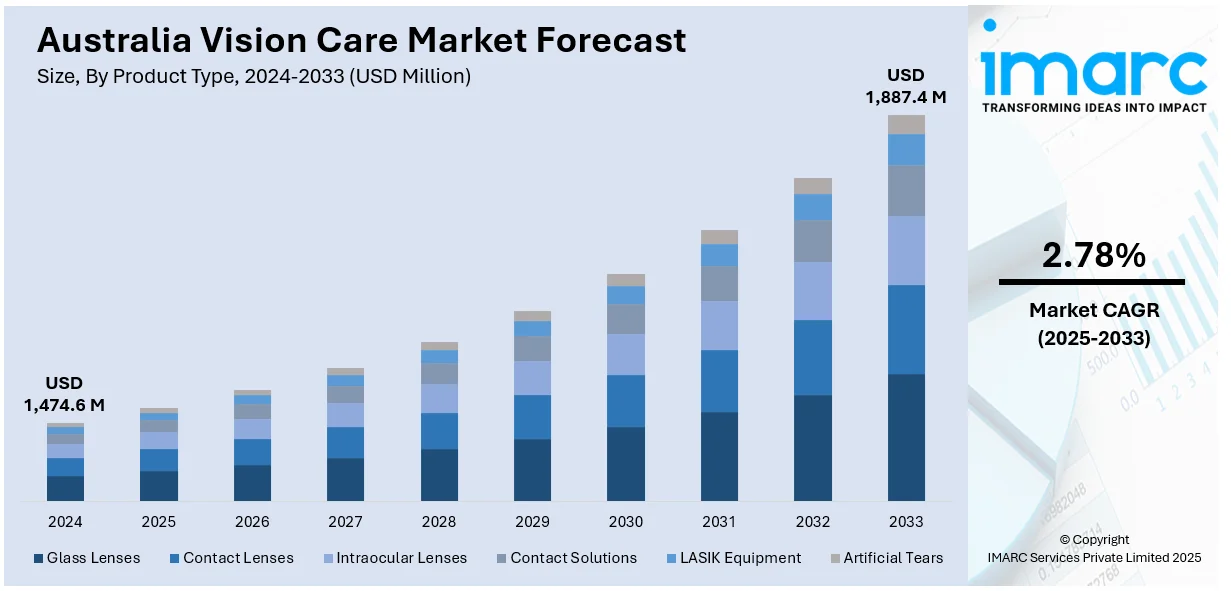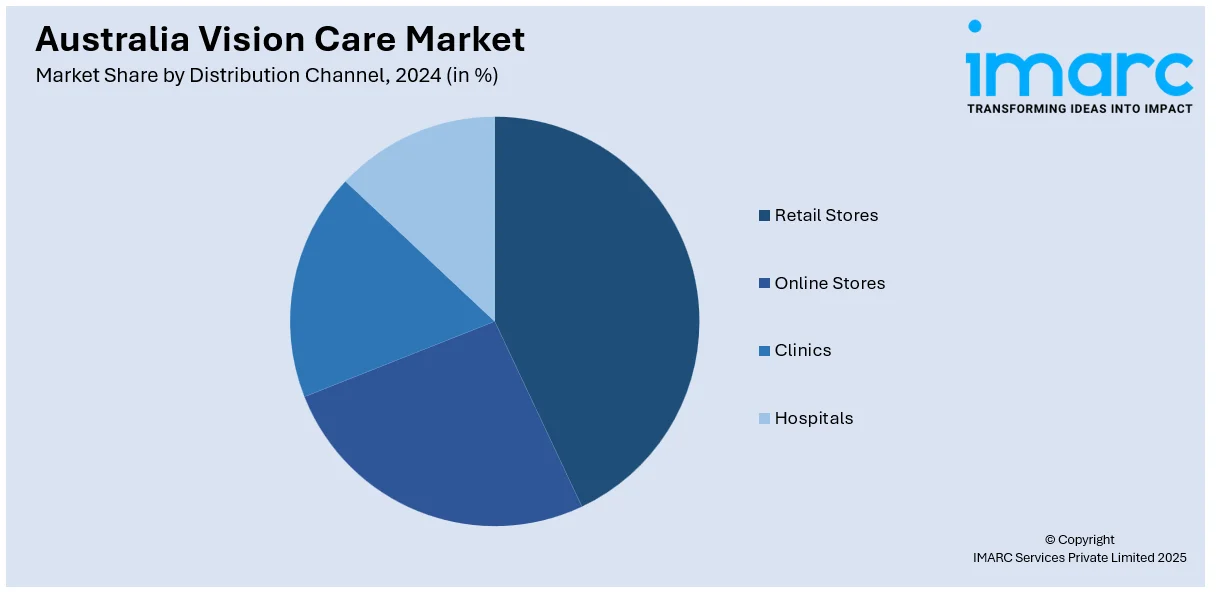
Australia Vision Care Market Size, Share, Trends and Forecast by Product Type, Distribution Channel, and Region, 2025-2033
Australia Vision Care Market Overview:
The Australia vision care market size reached USD 1,474.6 Million in 2024. Looking forward, IMARC Group expects the market to reach USD 1,887.4 Million by 2033, exhibiting a growth rate (CAGR) of 2.78% during 2025-2033. Government initiatives and public health programs, technological advancements in diagnostic tools, treatments, and eyewear, as well as innovations in contact lenses and smart eyewear, are collectively driving the market by improving accessibility, awareness, and the quality of vision care services.
|
Report Attribute
|
Key Statistics
|
|---|---|
|
Base Year
|
2024
|
|
Forecast Years
|
2025-2033
|
|
Historical Years
|
2019-2024
|
| Market Size in 2024 | USD 1,474.6 Million |
| Market Forecast in 2033 | USD 1,887.4 Million |
| Market Growth Rate 2025-2033 | 2.78% |
Australia Vision Care Market Trends:
Government Initiatives and Public Health Programs
Government initiatives and public health programs focused on enhancing eye health have been vital in fostering the expansion of the Australia vision care market. Initiatives that encourage consistent eye examinations, especially for at-risk populations like children, seniors, and those with long-term illnesses like diabetes are highlighting the significance of preserving healthy vision. Public health initiatives aimed at informing people about prevalent eye conditions and their prevention are motivating a greater number of individuals to pursue prompt eye care, leading to improved overall eye health. In addition, subsidized initiatives and screenings in rural or underserved regions are facilitating access to vision care services, enhancing participation rates in eye health management. In 2024, the Australian Medical Association (AMA) launched its "Vision for Australia's Health" at the national conference, addressing critical healthcare challenges such as long waiting lists, workforce shortages, and rising costs. AMA President Professor Steve Robson emphasized the need for innovative policies, investment in prevention, and better collaboration to ensure equitable access to healthcare. The vision aimed to improve the healthcare system and tackle the chronic disease burdens in an ageing population. These government-led efforts to ensure equitable access to vision care solutions are not only addressing urgent health concerns but also creating a positive environment for the expansion of the vision care market in Australia.

To get more information on this market, Request Sample
Technological Advancements in Vision Care Products and Services
Technological innovation is significantly shaping the expansion of the vision care market in Australia, with advances across diagnostics, treatments, and eyewear driving both accessibility and quality. Tools like optical coherence tomography (OCT) and laser-assisted procedures are streamlining the diagnosis and management of various ocular conditions, offering higher precision and faster recovery times. These enhancements are boosting patient confidence and improving clinical outcomes. Meanwhile, emerging categories such as smart eyewear and technologically integrated contact lenses are gaining popularity, appealing to individuals seeking advanced functionality, especially in lifestyle-oriented applications. Tele-optometry and online platforms are also making a mark, reducing the need for in-person consultations and extending services to remote or underserved regions. A notable example in 2024 was Johnson & Johnson’s launch of the ACUVUE OASYS MAX 1-Day contact lenses in Australia. These lenses featured TearStable Technology and OptiBlue light filtering, specifically addressing the needs of digital device users and individuals with presbyopia. With both spherical and multifocal options, they improved comfort and visual clarity in high-demand settings. This rollout reflects a broader industry push to combine innovation with everyday practicality. As such developments continue, they are not only expanding the product landscape but also elevating patient expectations and driving user adoption.
Australia Vision Care Market Segmentation:
IMARC Group provides an analysis of the key trends in each segment of the market, along with forecasts at the regional level for 2025-2033. Our report has categorized the market based on product type and distribution channel.
Product Type Insights:
- Glass Lenses
- Contact Lenses
- Intraocular Lenses
- Contact Solutions
- LASIK Equipment
- Artificial Tears
The report has provided a detailed breakup and analysis of the market based on the product type. This includes glass lenses, contact lenses, intraocular lenses, contact solutions, LASIK equipment, and artificial tears.
Distribution Channel Insights:

- Retail Stores
- Online Stores
- Clinics
- Hospitals
A detailed breakup and analysis of the market based on the distribution channel have also been provided in the report. This includes retail stores, online stores, clinics, and hospitals.
Regional Insights:
- Australia Capital Territory & New South Wales
- Victoria & Tasmania
- Queensland
- Northern Territory & Southern Australia
- Western Australia
The report has also provided a comprehensive analysis of all the major regional markets, which include Australia Capital Territory & New South Wales, Victoria & Tasmania, Queensland, Northern Territory & Southern Australia, and Western Australia.
Competitive Landscape:
The market research report has also provided a comprehensive analysis of the competitive landscape. Competitive analysis such as market structure, key player positioning, top winning strategies, competitive dashboard, and company evaluation quadrant has been covered in the report. Also, detailed profiles of all major companies have been provided.
Australia Vision Care Market News:
- In April 2025, HOYA Lens Australia partnered with Optometry Australia for a Myopia Awareness Campaign aimed at generating awareness about the growing myopia issue, particularly among children. The campaign, launching on April 7, 2025, will highlight prevention methods and promote MiYOSMART lenses, which reduce myopia progression by 60%. A follow-up campaign will launch in May 2025 to further educate parents and encourage early treatment.
- In June 2024, Alcon Vision Care launched its TOTAL30 monthly replacement contact lenses in Australia and New Zealand, offering spherical, toric, and multifocal designs. These lenses featured Water Gradient and Celligent Technology, providing comfort and performance for up to 30 days. The new product aimed to address discomfort issues seen in reusable lenses while offering a breakthrough in the reusable contact lens market.
Australia Vision Care Market Report Coverage:
| Report Features | Details |
|---|---|
| Base Year of the Analysis | 2024 |
| Historical Period | 2019-2024 |
| Forecast Period | 2025-2033 |
| Units | Million USD |
| Scope of the Report |
Exploration of Historical Trends and Market Outlook, Industry Catalysts and Challenges, Segment-Wise Historical and Future Market Assessment:
|
| Product Types Covered | Glass Lenses, Contact Lenses, Intraocular Lenses, Contact Solutions, LASIK Equipment, Artificial Tears |
| Distribution Channels Covered | Retail Stores, Online Stores, Clinics, Hospitals |
| Regions Covered | Australia Capital Territory & New South Wales, Victoria & Tasmania, Queensland, Northern Territory & Southern Australia, Western Australia |
| Customization Scope | 10% Free Customization |
| Post-Sale Analyst Support | 10-12 Weeks |
| Delivery Format | PDF and Excel through Email (We can also provide the editable version of the report in PPT/Word format on special request) |
Key Questions Answered in This Report:
- How has the Australia vision care market performed so far and how will it perform in the coming years?
- What is the breakup of the Australia vision care market on the basis of product type?
- What is the breakup of the Australia vision care market on the basis of distribution channel?
- What is the breakup of the Australia vision care market on the basis of region?
- What are the various stages in the value chain of the Australia vision care market?
- What are the key driving factors and challenges in the Australia vision care?
- What is the structure of the Australia vision care market and who are the key players?
- What is the degree of competition in the Australia vision care market?
Key Benefits for Stakeholders:
- IMARC’s industry report offers a comprehensive quantitative analysis of various market segments, historical and current market trends, market forecasts, and dynamics of the Australia vision care market from 2019-2033.
- The research report provides the latest information on the market drivers, challenges, and opportunities in the Australia vision care market.
- Porter's five forces analysis assist stakeholders in assessing the impact of new entrants, competitive rivalry, supplier power, buyer power, and the threat of substitution. It helps stakeholders to analyze the level of competition within the Australia vision care industry and its attractiveness.
- Competitive landscape allows stakeholders to understand their competitive environment and provides an insight into the current positions of key players in the market.
Need more help?
- Speak to our experienced analysts for insights on the current market scenarios.
- Include additional segments and countries to customize the report as per your requirement.
- Gain an unparalleled competitive advantage in your domain by understanding how to utilize the report and positively impacting your operations and revenue.
- For further assistance, please connect with our analysts.
 Request Customization
Request Customization
 Speak to an Analyst
Speak to an Analyst
 Request Brochure
Request Brochure
 Inquire Before Buying
Inquire Before Buying




.webp)




.webp)












